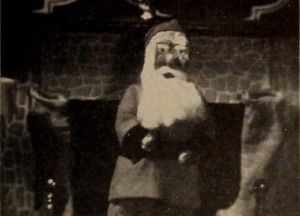
"Taking the familiar 'Twas the Night Before Christmas as a theme, Bert Seckendorf and Vic Watson have put together an appealing children's holiday film combining live action with animation. The live action interludes show a father reading the poem to his young son on Christmas Eve, with the familiar lines superimposed at the base of the scene. These connectives then fade out to miniature sets in which animated figures re-enact the well known story of St. Nick. The film suffers from some underexposure and uneven animation in places, but it offers a very pleasant holiday item." Movie Makers, Dec. 1949, 455,468.
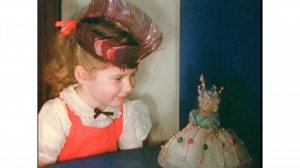
"The story of a little girl and the doll she wanted for Christmas. She asked for a fairy princess, got just a doll, but then the doll comes to life and dances, delighting the disillusioned miss and the film ends on a happy note." PSA Journal, Nov. 1956, 22.
"The First Christmas Gift is a 'first film'. It was made over a week-end, only two hundred feet of film were exposed to make a two hundred foot picture. This was part of the problem, for the film was a bit of 'home work' in the University course being pursued by the producer. Christmas actually having passed, it was necessary for the producer to manufacture the small Christmas tree used for atmosphere, and so also, the snow on the lady's coat was improvised from materials found at home on a Sunday" ("Program Notes," 1940).
"Green Christmas is a seven-minute gift from Roy Martin of Annandale, Va., done to the tune of Stan Freberg's recording of the same name. Clever animation and a wide use of imagination make this almost-too-long film quite entertaining. You'll like this version of how commercial Christmas can get. It's in glorious Christmas color" PSA Journal, Nov. 1969, 57.
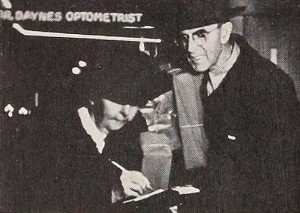
"A delightful film of the home is A Greene Christmas, produced by Mildred Greene. Here is a record of a domestic Christmas that may well serve as an exemplar to other movie makers who are tempted to wander far afield. No startling new stunts in technique or effects of continuity are displayed, yet the film is so homelike, pleasant and sincere that it commands recognition as an achievement. Naturally, however, all departments which contribute to the completion of the film are more than adequately handled. The interior lighting, which resulted in perfectly exposed color shots in the familiar home settings, is noteworthy. Special recognition should be accorded the successful, well exposed shots of the subjects out of doors at night in one sequence. All the actors, members of her immediate family and friends, including the producer, were naturally and pleasantly shown, but the palm for outstanding characterization must go to Miss Greene's mother, who played the part of herself in a most delightful and unaffected way. The preparation of the color titles for this film deserves special mention because of their perfect exposure, fine backgrounds and outstanding arrangement of metal script letters. (Miss Greene tells about making A Greene Christmas in Stretching Christmas, in this number of Movie Makers.)" Movie Makers, Dec. 1939, 609.
"Joyous Noel by Gilbert B. Jansen Jr. is the sort of color motion picture record of an American family's Christmas that so many home-loving cameramen dream of producing - but seldom do. Undoubtedly the producer and all members of his family will treasure this film immediately. Not a great work, Joyous Noel is nevertheless an unusually good Christmas film in which all of the preparations and celebrations found in graceful family living are depicted through the activities of a young couple and their two children. Well lighted scenes, technically proficient camera work, pleasant acting by all concerned, and a background of Christmas carol music all contribute to make this a thoroughly pleasant production" PSA Journal, Jan. 1955, 50.
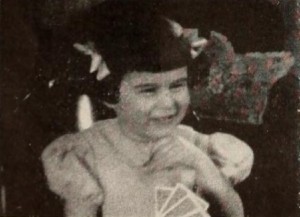
"Two children and a simple plot are ideal ingredients for a family film story. In Magic Stairway, Margaret and Harlan M. Webber have used this combination to develop a lively and natural movie of their son Roy and their daughter Janet. Roy longs for a punching bag for Christmas, but he feels that it is a too expensive gift to expect from his parents. He decides to earn the money for it with the help of his young sister. In beautifully filmed sequences, the children are shown melting castoff candles and remolding them into delicate shapes, to be sold to the neighbors. The profits mount slowly until the desired goal is reached. Then tragedy strikes when Janet accidentally breaks one of Mother's treasured teacups. The direction and cutting in this sequence are particularly skillful, as each person's reaction to the broken cup is registered. All is harmony on Christmas morning when Mother's gift from the children (bought with the punching bag money) is revealed as a replacement of the broken treasure. Needless to say, the children fare handsomely, with the punching bag starring as the climactic present. Faultless camera work and intelligent direction of the children contribute to make this film far above the average." Movie Makers, Dec. 1947, 514.
"An amusing, sophisticated treatment of a family Christmas. As the second film ever made by Mr. Hazard, "Merry Christmas" also won the first award and trophy at the 1955 Louisville international Exhibit of Photography. Excellent editing and directing result in the delightful skit of a tiny tot's premature discovery of Christmas tree and presents while parents are still sound asleep and of the mayhem that follows." PSA Journal, Dec. 1955, 35.
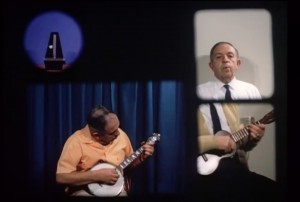
"Multiple Sidosis by Sidney N. Laverentz a PSA member of National City, California. Sid's title is a mind-boggler surpassed only by the unbelievable single frame multi-image exposures, all in synchronization, that is reminiscent of his winner of a few years ago, "One Man Band." This 10-minute 16mm film won for him a Ten Best medal and the Golden Microphone Award, the new title for the past Sound Award" PSA Journal, Nov. 1970, 38.
Total Pages: 3